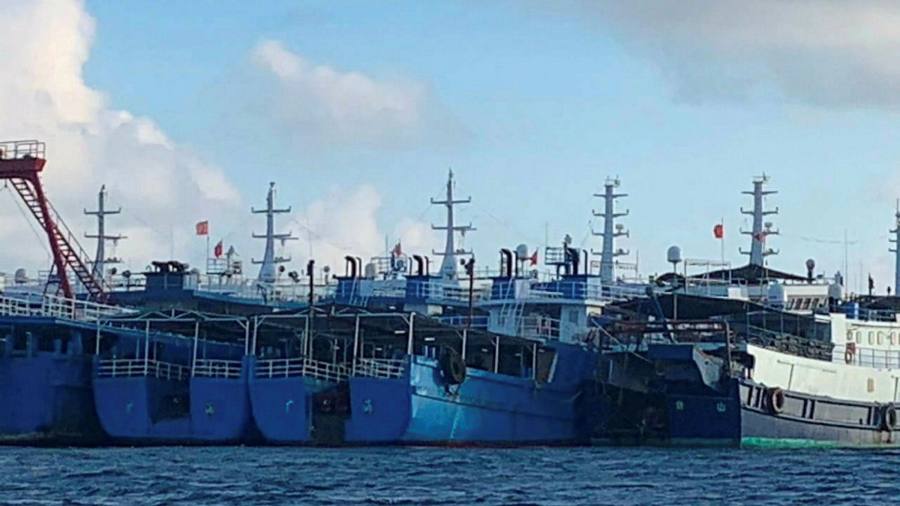[ad_1]
Manila and Beijing are locked in an unusually open and sour dispute over what the Philippines calls the “swarming and threatening presence†of more than 200 Chinese fishing vessels around a reef in the South China Sea.
China’s foreign ministry has accused the Philippines of “hyping†the issue and claimed that the vessels, thought to be part of its maritime militia, were merely “sheltering from the windâ€.
Rodrigo Duterte’s government pointed out that the weather had been fair in recent days while analysts said that similar incidents at sea often preceded China’s building of permanent structures on reefs and atolls to reinforce its maritime claims.Â
According to satellite photos and Philippine officials, the Chinese flotilla has been massed since last month around Whitsun Reef in the Spratly Islands, which Filipinos call Julian Felipe Reef.
The Philippines claims the area as part of its 200-mile Exclusive Economic Zone, and won a 2016 arbitration case against China that invalidated Beijing’s claims of historic rights to most of the sea, which it marks on maps in its “Nine-Dash Lineâ€.
On the other side of the Luzon Strait, China has stepped up its military posturing around Taiwan. The US fears that China is flirting with the idea of seizing control of Taiwan, which Beijing claims as part of its territory.
In the dispute around Whitsun Reef, Joe Biden’s new administration has backed the Philippines, with which the US has a mutual defence treaty.

“The United States stands with our ally, the Philippines, in the face of the PRC’s maritime militia amassing in the South China Sea,†Ned Price, the US state department spokesman, said on Wednesday. “We will always stand by our allies and stand up for the rules-based international order.â€
Duterte, who has pivoted foreign policy away from Washington and opened friendlier relations with China than any of his predecessors since taking power in 2016, met China’s ambassador in the Philippines last month to complain about the ships. Manila has also sent warplanes to patrol the area.
This week Delfin Lorenzana, the Philippines foreign minister, said that China was showing an “utter disregard †for international law that he described as “appallingâ€.
He added: “Its Nine-Dash Line claim is without any factual or legal basis.â€Â China’s embassy responded by saying the area was a traditional fishing ground for Chinese vessels, and accused Lorenzana of making “unprofessional remarks which may further fan irrational emotionsâ€.
Analysts said the dispute had echoes of China’s 1994 occupation of Mischief Reef, another atoll in the Spratlys. China originally built what it said were fishermen’s shelters, which it later developed into a base.Â
“This is the continuation of China’s now years-long strategy of employing the militia in large numbers to establish de facto control of waters and reefs around the South China Sea,†said Greg Poling, a senior fellow at the Center for Strategic and International Studies.
“The fact that the Philippine government is not just talking about it but actually documenting and publicising it is a big deal.â€Â

The dispute coincides with a sharp surge in coronavirus cases in the Philippines that has disrupted government business. On Wednesday Duterte cancelled a regular weekly address because of rising Covid-19 cases that have hit his staff. Lorenzana said he was self-isolating after testing positive for the virus.
This week, Chinese warplanes entered Japan and Taiwan’s air defence identification zones while a carrier group led by the Liaoning, the older of China’s two aircraft carriers, passed through the Miyako Strait near both Taiwan and Japanese waters on Sunday.
They were accompanied for the first time by the Nanchang Type 065 destroyer, a stealth vessel with anti-aircraft guided missiles.Â
China’s navy said that the drills were a routine effort to “raise our ability to protect national sovereigntyâ€, and added that it planned to conduct similar drills.Â
The US is worried that China’s maritime militia will grow even more threatening following a proposed revision to China’s coastguard law that may allow coastguard ships, which often accompany the militia, to use arms.Â
Ketian Vivian Zhang, a scholar at George Mason University in the US, said that China’s drills were a display of force and strength around the self-governed island meant to deter it from declaring independence.Â
She noted, however, that the rise in military activity did not match the tense period between 2012 and 2015 and was not particularly dangerous as long as both the US and China remained committed to avoiding conflict.Â
Taipei on Wednesday warned it would shoot down Chinese drones that had circled the Taiwan-controlled Pratas Islands in recent days if they crossed over the island. Separately, the USS John S McCain, a guided missile destroyer, also carried out a freedom of navigation operation in the Taiwan Strait.
[ad_2]
Source link






